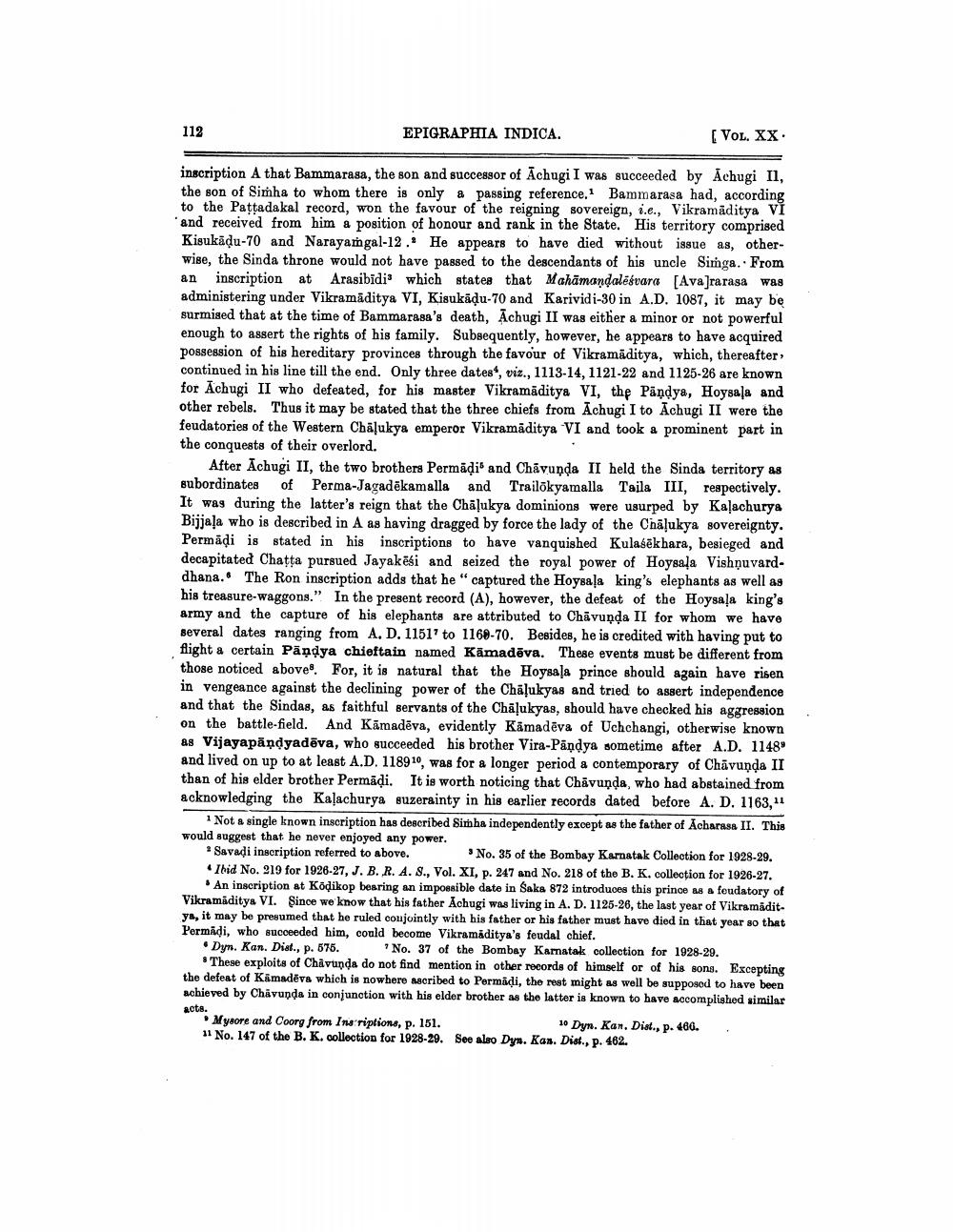________________
112
EPIGRAPHIA INDICA.
[VOL. XX.
inscription A that Bammarasa, the son and successor of Achugi I was succeeded by Achugi II, the son of Simha to whom there is only a passing reference. Bammarasa had, according to the Paṭṭadakal record, won the favour of the reigning sovereign, i.e., Vikramaditya VI and received from him a position of honour and rank in the State. His territory comprised Kisukaḍu-70 and Narayamgal-12. He appears to have died without issue as, otherwise, the Sinda throne would not have passed to the descendants of his uncle Simga. From an inscription at Arasibidi3 which states that Mahamandaleśvara [Ava]rarasa was administering under Vikramaditya VI, Kisukaḍu-70 and Karividi-30 in A.D. 1087, it may be surmised that at the time of Bammarasa's death, Achugi II was either a minor or not powerful enough to assert the rights of his family. Subsequently, however, he appears to have acquired possession of his hereditary provinces through the favour of Vikramaditya, which, thereafter, continued in his line till the end. Only three dates, viz., 1113-14, 1121-22 and 1125-26 are known for Achugi II who defeated, for his master Vikramaditya VI, the Pandya, Hoysala and other rebels. Thus it may be stated that the three chiefs from Achugi I to Achugi II were the feudatories of the Western Chalukya emperor Vikramaditya VI and took a prominent part in the conquests of their overlord.
After Achugi II, the two brothers Permaḍis and Chavunda II held the Sinda territory as subordinates of Perma-Jagadēkamalla and Trailōkyamalla Taila III, respectively. It was during the latter's reign that the Chalukya dominions were usurped by Kalachurya Bijjala who is described in A as having dragged by force the lady of the Chalukya sovereignty. Permadi is stated in his inscriptions to have vanquished Kulasekhara, besieged and decapitated Chaṭṭa pursued Jayakēsi and seized the royal power of Hoysala Vishnuvarddhana. The Ron inscription adds that he "captured the Hoysala king's elephants as well as his treasure-waggons." In the present record (A), however, the defeat of the Hoysala king's army and the capture of his elephants are attributed to Chavunda II for whom we have several dates ranging from A. D. 1151' to 1160-70. Besides, he is credited with having put to flight a certain Paṇḍya chieftain named Kamadeva. These events must be different from those noticed above. For, it is natural that the Hoysala prince should again have risen in vengeance against the declining power of the Chalukyas and tried to assert independence and that the Sindas, as faithful servants of the Chalukyas, should have checked his aggression on the battle-field. And Kamadeva, evidently Kamadeva of Uchchangi, otherwise known as Vijayapāṇḍyadeva, who succeeded his brother Vira-Pandya sometime after A.D. 1148" and lived on up to at least A.D. 118910, was for a longer period a contemporary of Chavunda II than of his elder brother Permaḍi. It is worth noticing that Chavunda, who had abstained from acknowledging the Kalachurya suzerainty in his earlier records dated before A. D. 1163,11
1 Not a single known inscription has described Simha independently except as the father of Acharasa II. This would suggest that he never enjoyed any power.
Savadi inscription referred to above.
No. 35 of the Bombay Karnatak Collection for 1928-29. Ibid No. 219 for 1926-27, J. B. R. A. S., Vol. XI, p. 247 and No. 218 of the B. K. collection for 1926-27. An inscription at Ködikop bearing an impossible date in Saka 872 introduces this prince as a feudatory of Vikramaditya VI. Since we know that his father Achugi was living in A. D. 1125-26, the last year of Vikramaditya, it may be presumed that he ruled conjointly with his father or his father must have died in that year so that Permadi, who succeeded him, could become Vikramaditya's feudal chief.
Dyn. Kan. Dist., p. 575.
"No. 37 of the Bombay Karnatak collection for 1928-29.
These exploits of Chavunda do not find mention in other records of himself or of his sons. Excepting the defeat of Kamadeva which is nowhere ascribed to Permaḍi, the rest might as well be supposed to have been achieved by Chavunda in conjunction with his elder brother as the latter is known to have accomplished similar acts. 10 Dyn. Kan. Dist., p. 466.
Mysore and Coorg from Inscriptions, p. 151.
11 No. 147 of the B. K. collection for 1928-29. See also Dyn. Kan. Dist., p. 462.




